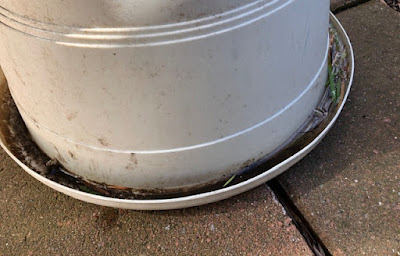
Very wet week could create soggy conditions

|
|
Rain will create pooling of water in container saucers,
so be sure to remove the saucers before the storm hits.
(Photo: Kathy Morrison)
|
Expect to get wet. After fretting over lack of winter rain, Sacramento will soak up what could be a month’s worth of precipitation between now and Tuesday night.
Estimates by the National Weather Service show 3 to 4 inches expected in Sacramento, 5 to 7.5 inches in Grass Valley. Most of the rain will be slow and steady as part of an atmospheric river.
“The main impacts from this moderate to heavy rain will be ponding on roadways and minor flooding in areas of poor drainage,” tweeted the weather service’s Sacramento office on Saturday morning.
More rain could follow on Wednesday and Thursday until the sun finally breaks through Friday, says the weather service.
Historically, December averages 3.5 inches of rain in Sacramento. Accompanied by heavy snow in the Sierra, this pre-Christmas deluge likely will get our water year back on track and alleviate some drought fears.
Such prolonged rain also will create soggy conditions in the garden. Hold off on transplanting bare-root roses, trees and berries until the soil has a chance to dry out.
* Protect potted poinsettias from cold and wet; they prefer it dry with temperatures in the high 60s, just like most people. Keep poinsettias in a sunny, warm location. Water thoroughly. After the holidays, feed your plants with a low-dose fertilizer monthly so they’ll bloom again next December.
* Make sure to poke holes in any foil wrapping around gift plants to allow drainage.
* Remove saucers under outdoor potted plants to avoid pooling of water and potential rot.
* Avoid walking on soggy soil; it compacts the soil – bad for roots and microorganisms.
* Keep gutters clear so storm water doesn’t pool or flood.
* Keep an eye on big trees, especially evergreens. Their foliage soaks up rain and puts a lot of extra weight on limbs. Redwoods in particular may become unstable due to root loss during drought. If a tree starts leaning, call an arborist.
* Just because it rained doesn't mean every plant got watered. Give a drink to plants that the rain didn't reach, such as under eaves or under evergreen trees.
* Clean and sharpen garden tools before storing for the winter.
Comments
0 comments have been posted.Sacramento Digs Gardening to your inbox.
Sites We Like
Garden Checklist for week of July 21
Your garden needs you!
* Keep your vegetable garden watered, mulched and weeded. Water before 8 a.m. to reduce the chance of fungal infection and to conserve moisture.
* Feed vegetable plants bone meal, rock phosphate or other fertilizers high in phosphate to stimulate more blooms and fruiting. (But wait until daily high temperatures drop out of the 100s.)
* Don’t let tomatoes wilt or dry out completely. Give tomatoes a deep watering two to three times a week.
* Harvest vegetables promptly to encourage plants to produce more. Squash especially tends to grow rapidly in hot weather. Keep an eye on zucchini.
* Pinch back chrysanthemums for bushy plants and more flowers in September.
* Remove spent flowers from roses, daylilies and other bloomers as they finish flowering.
* Pinch off blooms from basil so the plant will grow more leaves.
* Cut back lavender after flowering to promote a second bloom.
* It's not too late to add a splash of color. Plant petunias, snapdragons, zinnias and marigolds.
* From seed, plant corn, pumpkins, radishes, winter squash and sunflowers.